Click image for BBB rating
See our Privacy Policy
cool="cool" width="785" height="11537" border="0" cellpadding="0" cellspacing="0" gridx="16" showgridx="showgridx" usegridx="usegridx" gridy="16" showgridy="showgridy" usegridy="usegridy" bgcolor="#99ccff">
|
|
|
|
 |
|
|
|
|
|
|
Welcome to Spaightwood Galleries, Inc.
120 Main Street, Upton MA 01568-6193
You can follow us on Facebook and Twitter!
We blog regularly on Facebook and announce special events and special sales on both sites.
Oskar Kokoschka (Austria, 1886-1980, England): Original Lithographs 1910-1916
|
|
|
|
"Oskar Kokoschka was born at Pöchlarn on the Danube in 1886. His father was Czech and came from a well known family of Prague goldsmiths. He was perhaps rather work-shy: Kokoschka later said of him, 'From him I learned to endure poverty rather than work slavishly at distasteful work.' His mother came from the mountain region of Styria, and claimed to have second sight. As a boy, Kokoschka was not particularly attracted to art. He wanted to study chemistry but was recommended for a scholarship at the Vienna School of Arts and Crafts by a teacher who had been impressed by his drawings. He entered the School in 1905, the year in which he started to paint in oils, and in 1907 he found work at the Wiener Werkstotte. Soon he began to expand his activities to literature. Asked to produce a children's book, he wrote his own text, Die Traumenden Knaben (The Dreaming Youths), which was scarcely suitable for the young, but made a good basis for his distinctive illustrations. He also wrote two plays, Sphinx und Strohamann (The Sphinx and the Scarecrow), and Murder, Hoffnung der Frauen (Murderer, Hope of Women): these are now considered to mark the beginnings of Expressionist theatre in Germany.
"In 1908 Kokoschka's work was shown in the Kunstschau exhibition in Vienna, which featured the avant-garde group around Klimt. His contributions were a centre of controversy because of their Expressionist violence, and he was dismissed from the School of Arts and Crafts as a result. In 1909 his work was shown at the second Kunstschau, and his two plays were performed in the little open-air theatre attached to the exhibition buildings. There was a tremendous scandal because of their violence, and their unconventional and apparently irrational structure, and even the Werkstotte would no longer employ him. At one time he managed to keep alive by betting on his own capacity to drink visitors to Vienna under the table. His chief protector was the pioneer Modernist architect Adolf Loos, who secured portrait commissions for him. One portrait was of the satirical writer Karl Kraus, editor of Die Facket (The Torch). Kraus said of this: 'It is quite possible that those who know me will not recognize me. But it is certain that those who do not know me will recognize me.'
"In 1910 Kokoschka's luck changed. He went to Berlin and was taken up by Herwarth Walden, the energetic owner-editor of Der Sturm, who commissioned him to do title-page drawings for the magazine and used one for almost every issue. He was also given a contract by the powerful dealer Paul Cassirer. In 1911 he returned to Vienna and was appointed as assistant teacher at the very school which had dismissed him. He had a show at the Hagenbund in Vienna, of which the opening reception was attended by Archduke Franz Ferdinand, the heir to the throne, who exclaimed indignantly: 'This fellow's bones ought to be broken in his body!' Most important of all, in 1911 he began a passionate affair with Alma Mahler, the widow of the great composer, an elegant society beauty considerably older than himself. The year 1912 was better still—he was able to give up teaching and showed at the Sonderbund exhibition in Cologne, which united the whole German-speaking avant garde, and with the Blaue Reiter in Munich.
"By 1913 his relationship with Alma Mahler was beginning to show signs of strain. They travelled to Italy together, and on one occasion visited the Naples aquarium. Kokoschka watched an insect sting and paralyse a fish, before devouring it, and at once associated the scene with the woman by his side.
"He was still a controversial figure: when he began teaching art at a smart Viennese girls' school whose headmistress was known for her progressive views, some of the parents objected so strongly that the Austrian government actually banned him from teaching. War, when it broke out, seemed a release from an impossible relationship and an impossible situation. Adolf Loos used his influence to have him appointed Lieutenant in an exclusive regiment of dragoons with a particularly glamorous uniform. As soon as the appointment was gazetted Loos had a postcard made of Kokoschka in his finery which was sold in shops alongside those showing leading actresses.
"At the beginning of 1915 Kokoschka was seriously wounded—and briefly taken prisoner—in Galicia: he suffered a head injury and a bayonet wound to the lung. He spent a period of convalescence in Vienna, but was then sent to the Isonzo Front, where his health soon broke down completely. He went to Stockholm to consult a brain specialist and then to Dresden to try and recover his health. His anguish was as much mental as physical, and was perhaps connected with his residual feelings for Alma Mahler. To exorcize his obsession he commissioned a life-sized doll, complete and life-like in all details, which he treated like a living companion—it has even been said that he escorted it to the opera.
"After the end of the war the political situation in Dresden was very unstable, just as it was everywhere else in Germany, and Kokoschka formed part of a small, left-wing bohemian group. In the newly liberal climate of 1919 he was officially appointed Professor at the Dresden Academy, and this post brought with it a beautiful house and studio. Outside Dresden, his reputation continued to rise. The composer Paul Hindemith set Murderer, Hope of Women to music, and it received numerous performances, among them one at the Dresden State Opera. In 1922 Kokoschka was invited to exhibit at the Venice Biennale. His health had now improved and he was becoming restless. He resigned his post at the Dresden Academy in 1924, simply giving a note to the porter and leaving the city before his intentions had been discovered. A period of travel followed, financed by the proceeds of his now lucrative Cassirer contract. Using Munich as his main base he went all over Europe, and also to North Africa, Egypt, Turkey and Palestine. The year 1931 brought great success for him, despite the darkening political horizon: he had a show at the Kunsthalle in Mannheim which Cassirer's successors brought to the Galerie Georges Petit in Paris, where it did well with the Parisian public. However, from this triumph there also came a conflict. Kokoschka demanded more independence from his dealers; they, in turn, were anxious to establish his work as a staple commodity in the art market. Kokoschka broke with them, and there was an acrimonious exchange of letters in the Frankfurter Zeitung.
"In 1932 Kokoschka once again showed at the Venice Biennale, but now his reception was stormy. Mussolini made it plain that he disliked Kokoschka's art, and the pro-Nazi press in Germany seized the opportunity to attack him. By 1933 his finances were severely strained, and he left Paris for the provinces and then went to Vienna to be with his mother. He felt ill at ease in a city ruled by the fascist administration of Chancellor Dollfuss, and after his mother's death later that year he went to Prague and took Czech citizenship. The Austrian government tried to lure him back by offering him the Directorship of the School of Arts and Crafts, and in 1937 he was the subject of a major retrospective at the Osterreiches Museum fur Kunst und Industrie This perhaps meant less to him than the fact that his work was also on show that year in the Degenerate Art Exhibition in Munich—at the same time more than four hundred of his works were removed from German museums. In Prague he had met Olda Pavlovska, who was later to become his wife, and he was busy expressing support for the Republic cause in Spain.
"The Munich Agreement Of 1938 indicated that Prague was no longer a safe refuge. In September Kokoschka left for England. This was the logical choice, but it was also the only place in Europe where his art was very little known. The Kokoschkas were desperately poor. In 1939 they moved to Polperro in Cornwall where Oskar made watercolours of the local scenery and Olda ran a pastry shop to help their finances. The next year, however, they returned to London, as Kokoschka was convinced that their neighbours were suspicious of them. London bored and depressed him:
What am I to do in this hole [their London flat] ? I must invent new subjects for my paintings. I am quite starved for something to see. When the spring comes I feel how it stirs in me as in a migrant bird, and I become quite nervous: I must leave town and paint something real—a grasshopper or something. When I come back to town the landscapes turn into political pictures. My heart aches, but I cannot help it. I cannot just paint landscapes without taking any notice of what happens.
"His fortunes began to look up as soon as the war was over. In 1945 he received a symbolic tribute in war-battered Vienna: an exhibition shared with Klimt and Schiele, both long dead. In 1947 there was a large Kokoschka retrospective at the Kunsthalle in Berne, and in 1952 a room was devoted to his work at the 26th Venice Biennale, Kokoschka had become a British citizen in 1947, but was not eager to remain in a country which he felt had slighted him. In 1953 he began to run his School of Seeing at the Internationale Sommerakademie fur Bildende Kunst in Salzburg, thus re-establishing his ties with the Austrian milieu in which he began his career, and in the same year he settled permanently at Villeneuve on Lake Geneva. He was now once again an extremely celebrated artist, but he had drifted away from the post-war art world, and, though much respected, was a marginal figure by the time of his death in 1980." (Text from Edward Lucie-Smith, Lives of the Great 20th-Century Artists [London: Thames & Hudson, 1999], 81-83)
Since his death, there has been a revival of interest, coupled with a series of retropectives of his work (particularly the 1986 exhibition and accompanying book at the Goggenheim Museum). Dr. Heinz Spielmann has suggested in his introduction to a 1981 retrospective shown in both London and New York by his dealers, Marlborough Fine Arts and Marlborough Gallery, "Kokoschka's genius is displayed in his paintings and drawings no less than in his poems, dramas, and essays: he is invariably direct, often violent, always vivid and unconstrained. The basis of Kokoschka's ethical doctrine was that everyone must use his freedom even though it should lead to conflict or death. Consequently his art, even in life, is always dramatic and imbued with passionate sympathy." In an age when all of our options so often seem like choices between lesser evils, Kokoschka affirms the need to choose and to act and to accept the consequences however imperfect and to accept as well the responsibility for those choices.
Kokoschka's works are parts of the permanent collections of almost every major museum in the world.
Selected Bibliography: Richard S. Field, Oskar Kokoschka (Storrs: William Benton Museum of Art, The University of Connecticut, 1977; E. H. Gombrich, Kokoschka in His Time (London: Tate Gallery, 1986); E. H. Gombrich, Bethusy-Huc, Fritz Novotny, Hans Bolliger, Jan Tomes, Bernhard Baer, Homage to Kokoschka: Prints and Drawings lent by Reinhold, Count Bethusy-Huc (London: Victoria and Albert Museum, 1976); Solomon R. Guggenheim Museum, Oskar Kokoschka 1886-1980 (NY: Solomon R. Guggenheim Museum, 1986); J.P. Hodin, Kokoschka: The Artist and His Time (Greenwich: New York Graphic Society, 1966); Oskar Kokoschka, My Life trans, David Britt (NY: Macmillan, 1974); Oskar Kokoschka, Oskar Kokoschka : Letters, 1905–1976 selected by Olda Kokoschka and Alfred Marnau, foreword by E. H. Gombrich (London: Thames & Hudson, 1992); Ernest Rathenau, ed., Oskar Kokoschka Drawings, 1906-1965 (Coral Gables: University of Miami Press, 1970); Santa Barbara Museum of Art, Orbis Pictus. The Prints of Oskar Kokoschka 1906-1976 (Santa Barbara: Santa Barbara Museum of Art, 1987); Serge Sabarsky, Oskar Kokoschka: Die Fruhen Jahre. Zeichnungen und Aquarelle (catalogue for a traveling retrospective shown at the Historisches Museum der Stadt Wien (9 December 1982 - 30 January 1983); Museum Villa Stuck, Munchen (7 April - 24 May 1983); Neue Galerie der Stadt Linz, Wolfgang Gurlitz Museum (31 May - 17 July 1983); Salzburger Museum Carolino Augusteum (22 July - 4 September 1983; published Vienna, 1982); Serge Sabarsky, Oskar Kokoschka Drawings and Watercolors The Early Years: 1906 to 1924 with essays by Serge Sabarsky, Oskar Kokoschka, and Achille Bonito Oliva (NY: Rizzoli, 1983); Fritz Schmalenbach, Oskar Kokoschka (Greenwich: New York Graphic Society, 1967); Klaus Albrecht Schroder and Johann Winkler, ed. Oskar Kokoschka (Munich: Prestel, 1991); Staatliches Museum Schloss Burgk, Oskar Kokoschka: Buchillustrationen 1908-1970 (Pirckheimer-Kabinett: Staatliches Museum Schloss Burgk, 1981); Tate Gallery, Oskar Kokoschka 1886-1980 (London: Tate Gallery 1986); Peter Vergo, Art in Vienna, 1898–1918. Klimt, Kokoschka, Schiele and their Contemporaries (London: Phaidon, 1975); Frank Whitford, Oskar Kokoschka A Life (London: Weidenfeld And Nicolson, 1986); H. M. Wingler and O. Welz, Oskar Kokoschka. Das druckgraphische Werk. 2 Vols. (Salzburg: 1975-80; Catalogue Raisonne of the Complete Prints with 567 works illustrated); H. M. Wingler, Oskar Kokoschka: The Work of the Painter (Verlag Galerie Welz, 1958); Johann Winkler & Katharina Schulz, Oskar Kokoschka (1886-1980): The Late Work, 1953-1980 (London: Marlborough Fine Art, 1990).
|
|
|
|
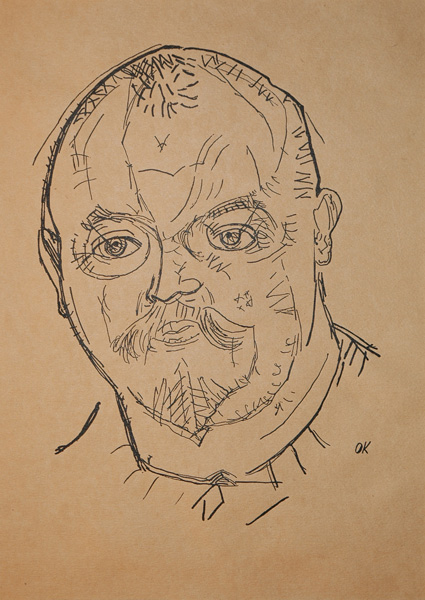 |
|
|
|
Portrait of Paul Scheerbart. Original lithograph, 1910. Edition: Published in Der Sturm (Berlin, Nr. 27 v. 1, Sept. 1910). Illustrated in Werner J. Schweiger, "Oskar Kokoschka: Der Strum. Die Berliner Jahre 1910-1916. Eine Dokumentation," p. 21. Image size: 260x195mm. Price: Please call or email for current pricing information.
|
|
|
|
|
|
|
 |
|
|
|
Der Mann im Boot / The man in the boat (Wingler-Welz 55, Davis-Rifkind 1563-3). Original lithograph, 1914. Edition: Published in 1915 in Zeit-Echo I: 20 as part of Allos Makar, a title that is an anagram for Alma-Oskar, combining his first name with that of Alma Mahler, with whom he was completely obsessed. Except for a few artist's proofs, this was the only appearance of this lithograph in print. Signed in the stone with the monogram. Rare. Image size: 144x191mm. Price: Please call or email for current pricing information.
|
|
|
|
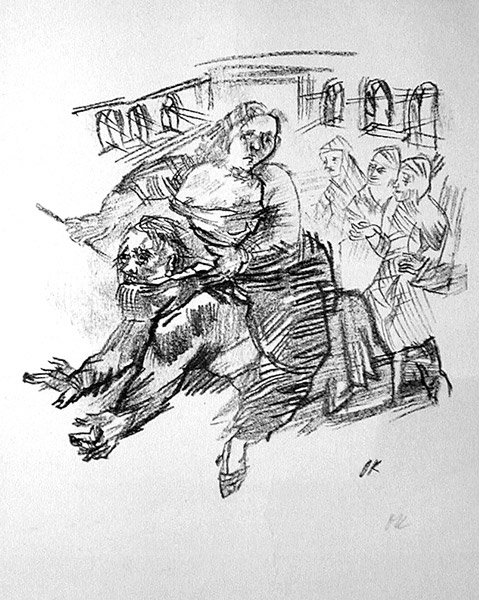 |
|
|
Aristoteles und Phyllis (Davis-Rifkind 1561: 2, Wingler-Welz 36). Original lithograph, 1914. Initialed in pencil lower right and signed in the stone. A fine impression with full margins. Ours is one of 30 signed and numbered impressions with large margins from the portfolio edition. There was also a book edition of 200 for Die chinesische Mauer / The Chinese wall (Leipzig: Kurt Wolff Verlag, 1914). The image depicts the philosopher Aristotle saddled and ridden by Phyllis, a young woman whom he had previously told Alexander to avoid because rulers needed to rule their passions. After Aristotle himself fell in love with her, she punished him by showing him that men are indeed the slaves of their lusts. A favorite theme in the art of the early German Renaissance, Kokoschka is here reviving it in recognition of his own enslavement to his desires for Alma Mahler. Image size: 280x278mm (plus large margins). Price: Please call or email for current pricing information.
|
|
|
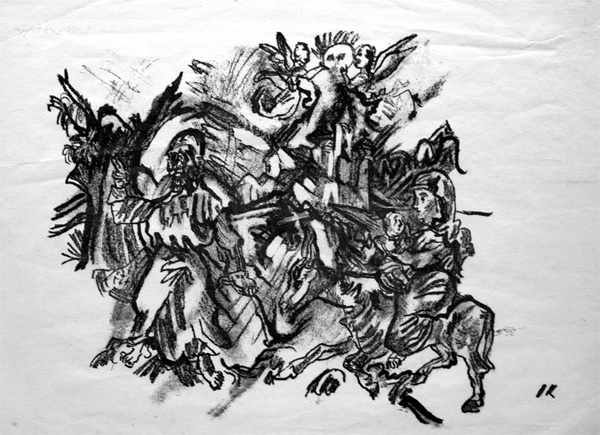 |
|
|
|
The Flight into Egypt (Wingler-Welz 55). Original lithograph, 1913. Edition: Published in 1914 by Graphisches Kabinett I. B. Neumann and in 1916 by Fritz Gurlitt in 1916 on Zanders-Bütten measuring 342x431mm. If we take Kokoschka at his word in a 1916 letter to Alma Mahler quoted on the next webpage, this should represent the objective, idealistic view of the world for which he has been striving and which he finally achieved in "The Bound Columbus," but if that is the case, then we must acknowledge that the objective view of the world shows that Kokoschka's idealistic view, while it admits the possibility of idealism, limits it here to the Virgin and her Child, for everyone else seems to be fleeing through a distinctly dark and chaotic landscape while only Jesus and Mary seem to be without fear or doubt. Our impression is from the 1914 edition and bears an upside-down signature in the upper left corner. Bottom of sheet trimmed not affecting image. Image size: 255x315mm. Price: Please call or email for current pricing information.
|
|
|
|
|
 |
|
In 1916, Paul Cassirer started a new periodical Der Bildermann: Steinzeichnungen fürs deutsche Volk (The Picture Man. Lithographs for the German People). Each issue had about 6 tabloid size pages with 4 full-page lithographs with print net to an illustrated poem, or two printed pages with texts of poetry. There was also a limited edition of 75 on large paper. Der Bildermann published from April to December 1516, changing from being patriotic and supportive of the war to sympathetic to the victims of the war and pessimistic about the whole enterprise of the war. Heckel's pieces featured sad views; Kirchner and Jaeckel became more lyrical; Barlach became ant-death, and Kokoschka presented a Passion in 6 lithographs and an afterword, 6 of which follow. (taken from Orrel P. REad Jr., German Expressionist Art: The Robert Gore Rifkind Collection (Los Angeles: Frederick S. Wight Art Gallery, UCLA, 1977), pp. 209-210.
|
|
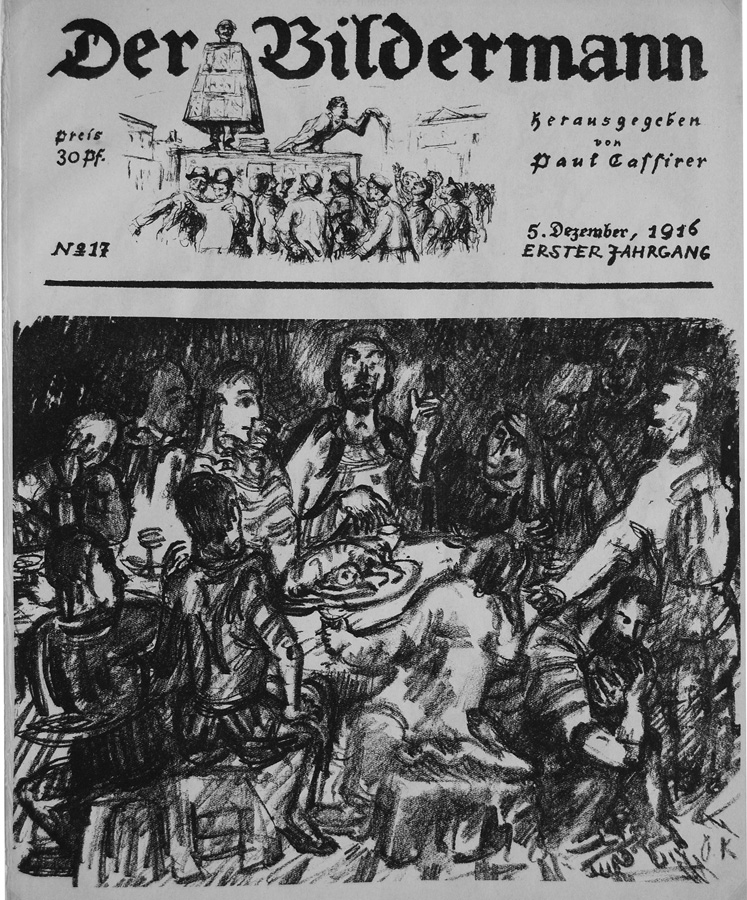 |
|
|
Das Abendmehl / The Last Supper. (Davis-Rifkind 1565, Wingler-Welz 83). Original lithograph, 1916. Published in Der Bildermann (1916). Signed in the stone lower right. Image size: 210x268mm. Price: Please call or email for current pricing information.
|
|
|
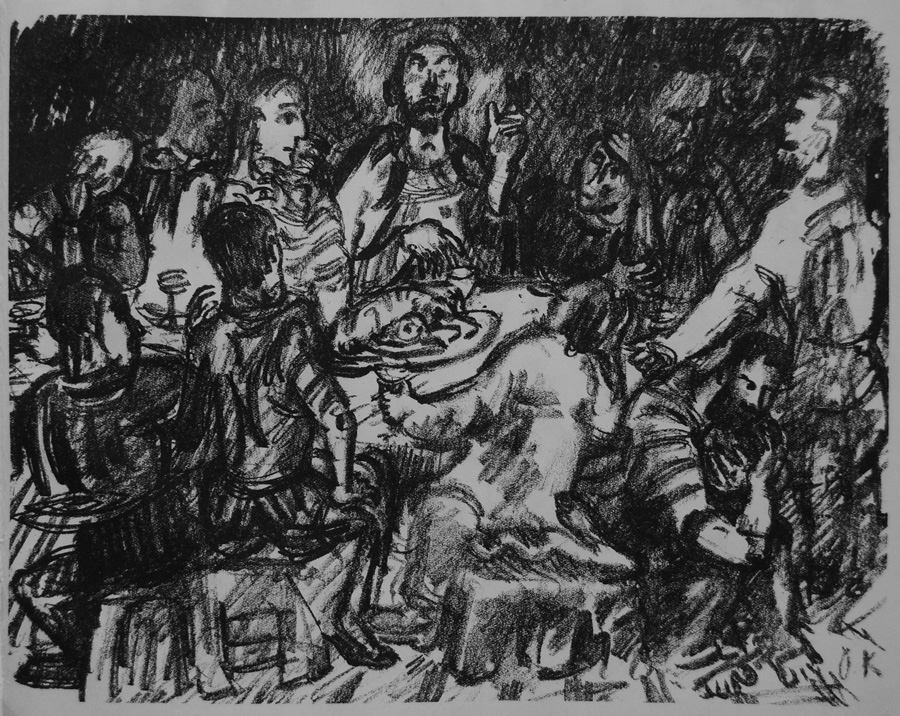 |
|
|
Das Abendmehl / The Last Supper. (Davis-Rifkind 1565, Wingler-Welz 83). Original lithograph, 1916. Published in Der Bildermann (1916). Signed in the stone lower right. Image size: 210x268mm. Price: Please call or email for current pricing information.
|
|
|
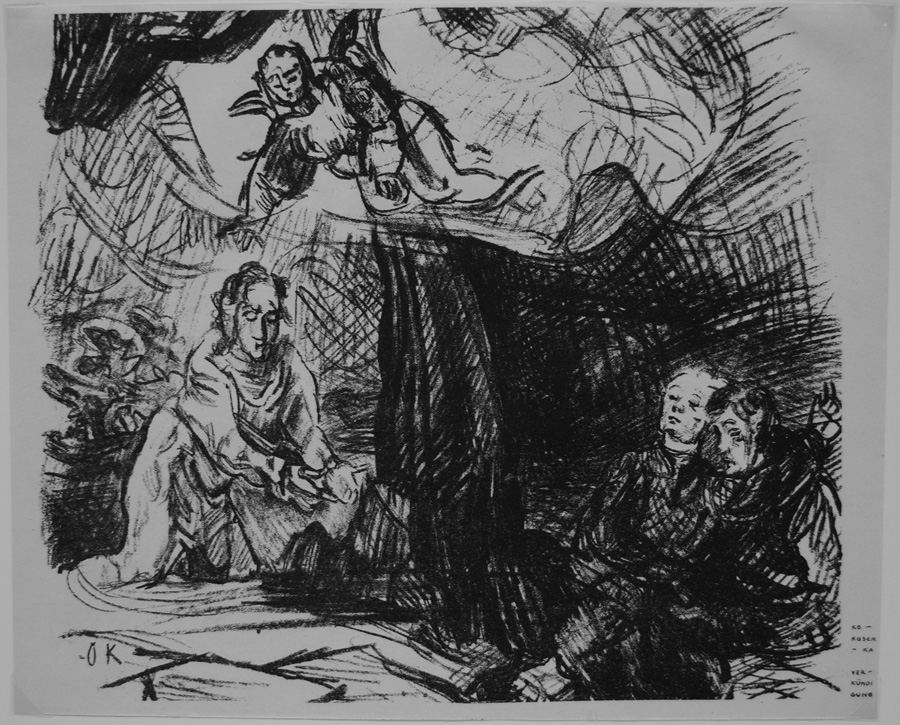 |
|
|
Christus am Ölberg / Christ on the Mount of Olives. (Davis-Rifkind 1569, Wingler-Welz 72). Original lithograph, 1916. Published in Der Bildermann (1916). Signed in the stone lower left. Image size: 252x300mm. Price: Please call or email for current pricing information.
|
|
|
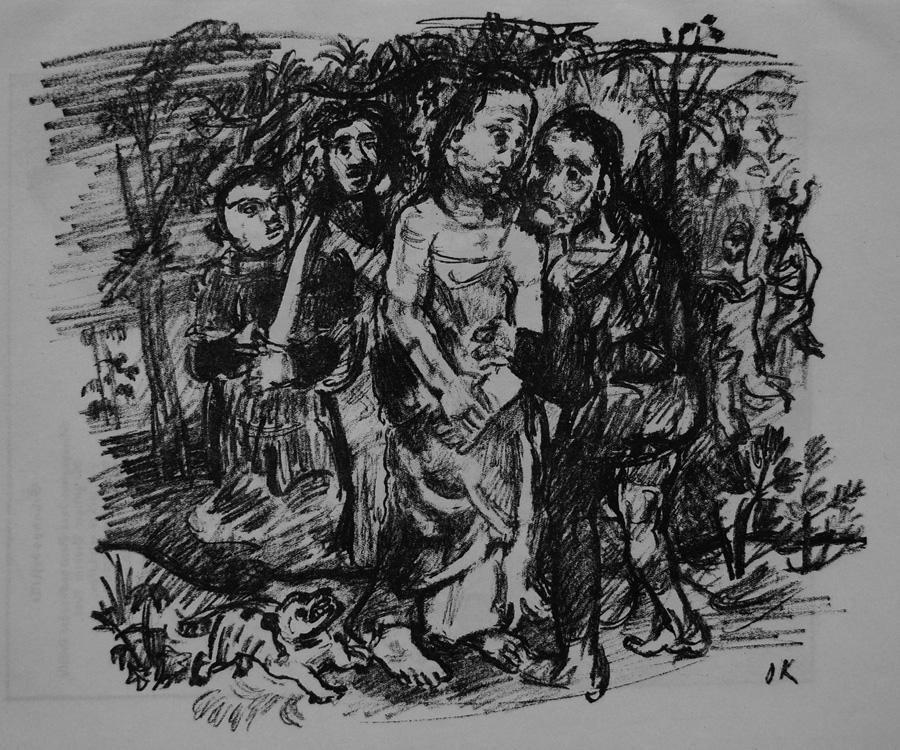 |
|
|
Der Judakuss / The kiss of Judas. (Davis-Rifkind 1570, Wingler-Welz 82). Original lithograph, 1916. Published in Der Bildermann (1916). Signed in the stone lower right. In this scene, the other disciples have already fled; there is no one but Jesus, Judas, and the Temple Gurad. ublished in Der Bilderman (1916). Image size: 242x285mm. Price: Please call or email for current pricing information.
|
|
|
|
|
 |
|
|
Christus am Kreuz / Christ on the Cross. (Davis-Rifkind 1568, Wingler-Welz 78). Original lithograph, 1916. Jesus stands hold the banner of the Resurrection; three guards have been knocked to the ground by the force of the life returning to Christ. The two standing figures on either side of Jesus seem to be angels. Published in Der Bildermann (1916). Illustrated in the Munich Haus der Kunst exhibition of Kokoschka's Graphic Work in 1976. Signed in the stone lower right. Image size: 267x315mm. Price: Please call or email for current pricing information.
|
|
|
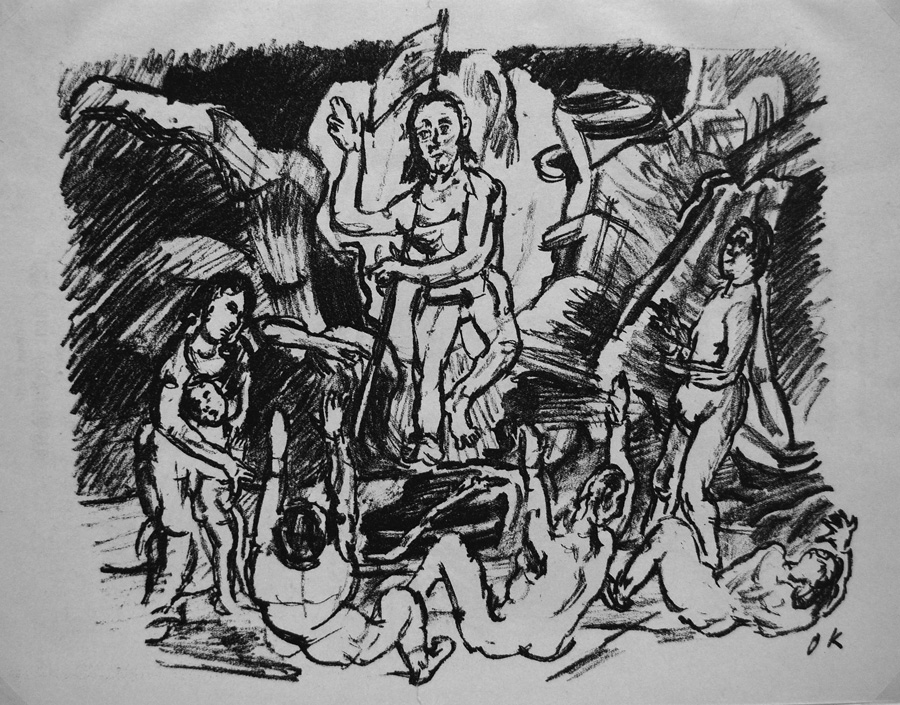 |
|
|
|
The Resurrection. (Davis-Rifkind 1566, Wingler-Welz 81). Original lithograph, 1916. Jesus stands hold the banner of the Resurrection; three guards have been knocked to the ground by the force of the life returning to Christ. The two standing figures on either side of Jesus seem to be angels. Published in Der Bildermann (1916). Illustrated in the Munich Haus der Kunst exhibition of Kokoschka's Graphic Work in 1976. Signed in the stone lower right. Half-inch tear bottom centerto the heal of the falling figure, quarter-inch tear center just to the left of the top of Christ's banner Image size: 252x300mm. Price: Please call or email for current pricing information.
|
|
|
|
|
We have not yet found an impression of Christ crowned with thorns (Davis-Rifkind 1567, Wingler-Welz 79). Der Bildermann's and Kokoschka's left-wing sentiments would not have served them well from 1917 to 1945 when Nazi Germany capitulated. Between those dates, however, several reigns of right-wing terror, the Nazi regime itself, the allied bombing of Germany during World War II, and the politics and pschology of defeat would all have combined to a near total destruction of copies of Der Bildermann and many of its readers. As mentioned above, Kokoschka's works were incleded in the Nazi's pirging Degenerate Art Exhibition in Munich and more than four hundred of his works were removed from German museums. It should not be in the least surpringin that copies of Der Bildermann are very scarce.
|
|
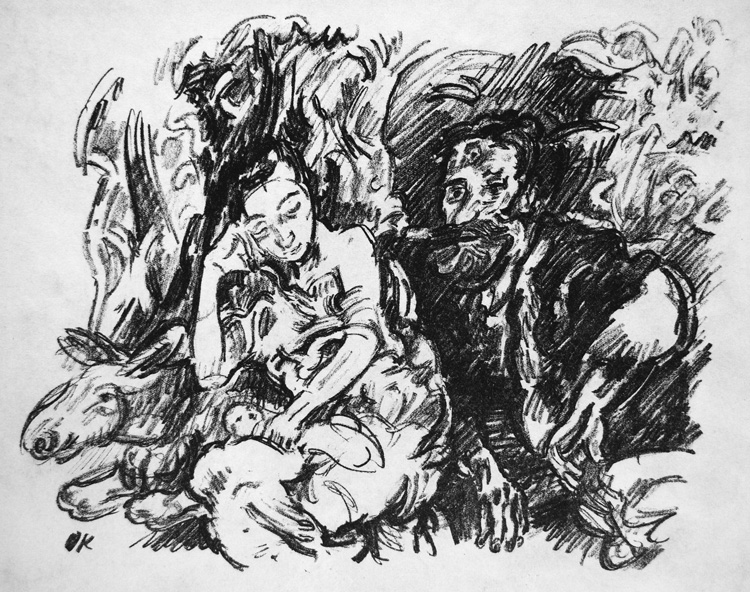 |
|
|
Rest on The Flight into Egypt (Davis-Rifkind 1571, Wingler-Welz 84). Original lithograph, 1916. This is not a part of Kokoschka's abbreviated Passion but a prophecy of what would later happen to the little baby Jesus fleeings Herod's would-be murderer's with his family. Published in Der Bilderman (1916). Signed in the stone lower left. Image size: 210x268mm. Price: Please call or email for current pricing information.
|
|
|
|
|
Spaightwood Galleries, Inc.
To purchase, call us at 1-800-809-3343 (1-508-529-2511 in Upton MA & vicinity) or send an email to spaightwood@gmail.com
We accept AmericanExpress, DiscoverCard, MasterCard, and Visa.
We also accept wire transfers and paypal.
For directions and visiting information, please call. We are, of course, always available over the web and by telephone (see above for contact information). Click the following for links to past shows and artists. For a visual tour of the gallery, please click here. For information about Andy Weiner and Sonja Hansard-Weiner, please click here. For a list of special offers currently available, see Specials.
All works are sold with an unconditional guarantee of authenticity (as described in our website listing).
Copyright 2004-2017, Spaightwood Galleries, Inc.
Go back to the top of this page.
Visiting hours: Saturday 10:00 am to 5:00 pm and Sunday noon to 6:00 pm and other times by arrangement.
Please call to confirm your visit. Browsers and guests are welcome.
|
|
|
|
|
|
|
|
|
|
|
|
|
|
|
|
|
|
|
|
|
|
|
|
|
|
|
|
|
|
|
|
|
|
|
|











